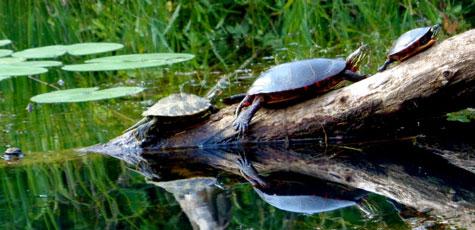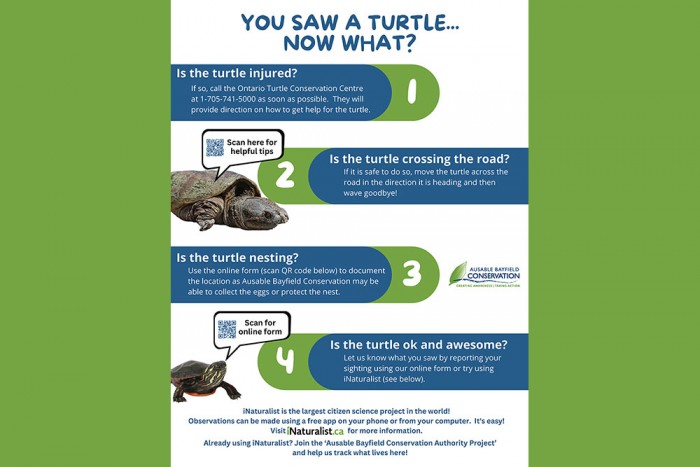Turtles
Ontario’s native freshwater turtles face many threats including habitat loss and road mortality (death by cars and other vehicles). Hundreds of turtles in Ontario are hit by cars each year. These could be gravid (pregnant) females looking for a place to lay eggs, or turtles looking for new habitat and mates. People can help turtles by creating and enhancing habitat on their properties, helping turtles cross the road in the direction they are heading (when it is safe to do so), and working with their local municipalities and communities to erect turtle crossing signs and build safe passages.
People can also arrange for transport of injured turtles to the turtle hospital.
Turtles are important links in food webs and provide essential ecological services, said Hope Brock, Healthy Watersheds Specialist at Ausable Bayfield Conservation. Snapping turtles, for example, help to control aquatic vegetation and clean creeks and wetlands by eating algae and dead and decaying fish and other organisms. They also cycle nutrients and spread seeds which benefit other organisms.
People can protect turtles, she said, by watching for turtles on roads when driving, helping them safely cross roads in the way they are headed, protecting nests from predators, and reporting turtle sightings to community monitoring projects. Enhancing turtle habitat is also vital.
“Preserving and creating habitat for turtles and other species is one of the most important things we can do to sustain our turtle species,” Hope said. “There has been a huge increase in the interest in turtles and protecting turtles in our watershed, so I also want to thank people for these efforts,” she said. “Thank you for your continued curiosity and for your desire to help these at-risk animals.”
To learn more visit the Huron Stewardship Council website, and the Ausable Bayfield Conservation turtles web page, or email HSC (huronstewardship@gmail.com).
(Photos by Jory Mullen)
About Turtles
To learn more about Ontario's eight freshwater turtle species (all species at risk) and how to protect them, please continue reading this web page.
Please report your turtle sightings using one of the following options:
For those who are reporting turtle sightings (for example, along the South Huron Trail), especially those turtles that are nesting, we invite you to submit your sightings through our online turtle sighting reporting form:
- Download the 'You Saw a Turtle. Now What ...? poster – 200 KB (medium-sized) PDF file.
How to get started with iNaturalist:
- Create an account with iNaturalist
- Join Ausable Bayfield Conservation Authority Project or Port Franks and Grand Bend Community Reptile Monitoring Project or both to log your information.
Build turtle nest egg protectors
To help protect Ontario's freshwater turtles, you may build nest protectors for the turtle eggs.
To learn how, here's a design fact sheet from Canadian Wildlife Federation
- Download the How to Build a Turtle Protector During Nesting Season – 2 MB large PDF file – a fact sheet from Canadian Wildlife Federation
More Turtle Content
The community group that met for a year to develop the Conservation Strategy said Ausable Bayfield Conservation and other partners should protect water, soil, and living things ... including turtles.
Ontario’s freshwater turtles play an important role in local ecosystems. These important reptiles face numerous threats in Canada and around the world, according to Ausable Bayfield Conservation.
“Local turtle populations can be affected by the loss of even one adult turtle,” said Hope Brock, Healthy Watersheds Technician with Ausable Bayfield Conservation.
The Port Franks Community Turtle Monitoring Program has been taking place for more than half a decade. “Local people help to let us know about the turtles they see and we are very thankful for that,” said Brock. “When we know how many turtles there are and what habitat they are using, it helps in our work to protect them and preserve their vital role in local watercourses.”
The local ecological system of water and land depends on having diverse animals that each play a role to keep that system healthy. The turtle is a vital part of that ecosystem. Turtles help to control aquatic vegetation. Turtles serve as scavengers. This means they help clean our creeks and wetlands by eating dead and decaying fish and other organisms.
Ontario turtle numbers are going down. Some of Ontario’s turtles are species at risk under the Ontario Endangered Species Act, 2007 and the federal Species at Risk Act.
The likelihood of offspring survival in turtles is very low, which means that a female turtle will have to lay many eggs over the course of her life for just one of her offspring to survive. Turtle numbers are in decline because of factors such as death on roadways, decline in habitat, slow rates of reproduction, and eating of eggs (predation) by predators such as raccoons or skunks.
The important role that turtles play, and the worrisome decline in turtle numbers, make the local Port Franks Area Community Turtle Monitoring Program very important, according to Brock.
The turtle monitoring workshop is held with the support of Ausable Bayfield Conservation Foundation (ABCF) and Ausable Bayfield Conservation Authority (ABCA).
Turtle species
Ontario has eight native turtle species. All eight of these species can be found in Ausable Bayfield Conservation watersheds. These species are as follows:
- Blanding’s Turtle (Emydoidea blandingii)
- Eastern Musk Turtle (Stinkpot) (Sternotherus odoratus)
- Midland Painted Turtle (Chrysemys picta marginata)
- Northern Map Turtle (Graptemys geographica)
- Snapping Turtle (Chelydra serpentina)
- Spiny Softshell Turtle (Apalone spinifera)
- Spotted Turtle (Clemmys guttata)
- Wood Turtle (Glyptemys insculpta)
Turtle Sighting Reporting Form
Ausable Bayfield Conservation would like to hear about your turtle sightings.
For more information on these turtle species, please visit this link: Ontario Nature Reptiles and Amphibians.
What to do if you find a turtle on the road
Female turtles need to leave the water to lay their eggs on dry ground. They typically do this from late May to early July. They often need to cross roads to get to suitable nesting areas. Sometimes they may even nest on the sides of roads.
If you find a turtle on the road, please help it across safely (only if it is safe for you to do so). Always move the turtle in the direction that it is heading.
Most turtles can be picked up carefully with two hands. When handling Snapping Turtles keep a safe distance from their head as they will snap at you if they feel threatened. You can grab the back of the shell and gently drag it across the road. Or, you may want to use a shovel, blanket, or car mat to move the turtle. Never pick up a turtle by the tail as this could damage its spine.
What to do if you find an injured turtle
- Carefully place the injured turtle in a box or well-ventilated plastic container with a secure lid (turtles can climb!)
Most turtles can be picked up carefully with two hands.
When handling Snapping Turtles keep a safe distance from their head as they will snap at you if they feel threatened. You may want to use a shovel or board to lift the turtle.
Note the location (road and major intersections) where the turtle was found to ensure it can be released according to provincial regulations.
Do not transport turtles in water. Do not offer the turtle anything to eat.
Take the turtle to:
- Salthaven Wildlife Rehabilitation Centre, P.O. Box 601, Mt Brydges, ON, NOL 1WO • 519-264-2440
- Turtle Haven, 114 Mansion Street Kitchener, ON, N2H 2J9 • 519-745-4334
- Georgian Bay Turtle Hospital-Oro-Medonte, ON, L3V 6H1
- Kawartha Turtle Trauma Centre, 1434 Chemong Road 4, Peterborough, ON, K9J 6X2 • 705-741-5000
- Toronto Wildlife Centre, 60 Carl Hall Road, Toronto, ON, M3K 2C1 • 416-631-0662
- Heaven’s Wildlife Rescue, Oil Springs, 519-466-6636.
Volunteer couriers may be able to drive the turtle to a rehabilitation centre if you cannot. Please call first.
Even if the turtle cannot be saved, wildlife rehabilitation staff may be able to save the eggs inside her!
The local ecological system depends on having diverse animals that each play a role to keep that system healthy. The turtle is a vital part of that eco-system. Turtles help to control aquatic vegetation. Turtles serve as scavengers. This means they help clean our creeks and wetlands by eating dead and decaying fish and other organisms.
It takes a long time for most turtles to reach maturity. Mature turtles may live a long time but turtles reproduce at a low rate. Any time a mother turtle dies, or any adult turtle dies, there is an impact on the future of the species. A Snapping Turtle would have to lay about 1,400 eggs in her lifetime, on average, in order for just one of her offspring to survive to adulthood. Saving even one adult by safely moving it across the road can help to conserve that species.

